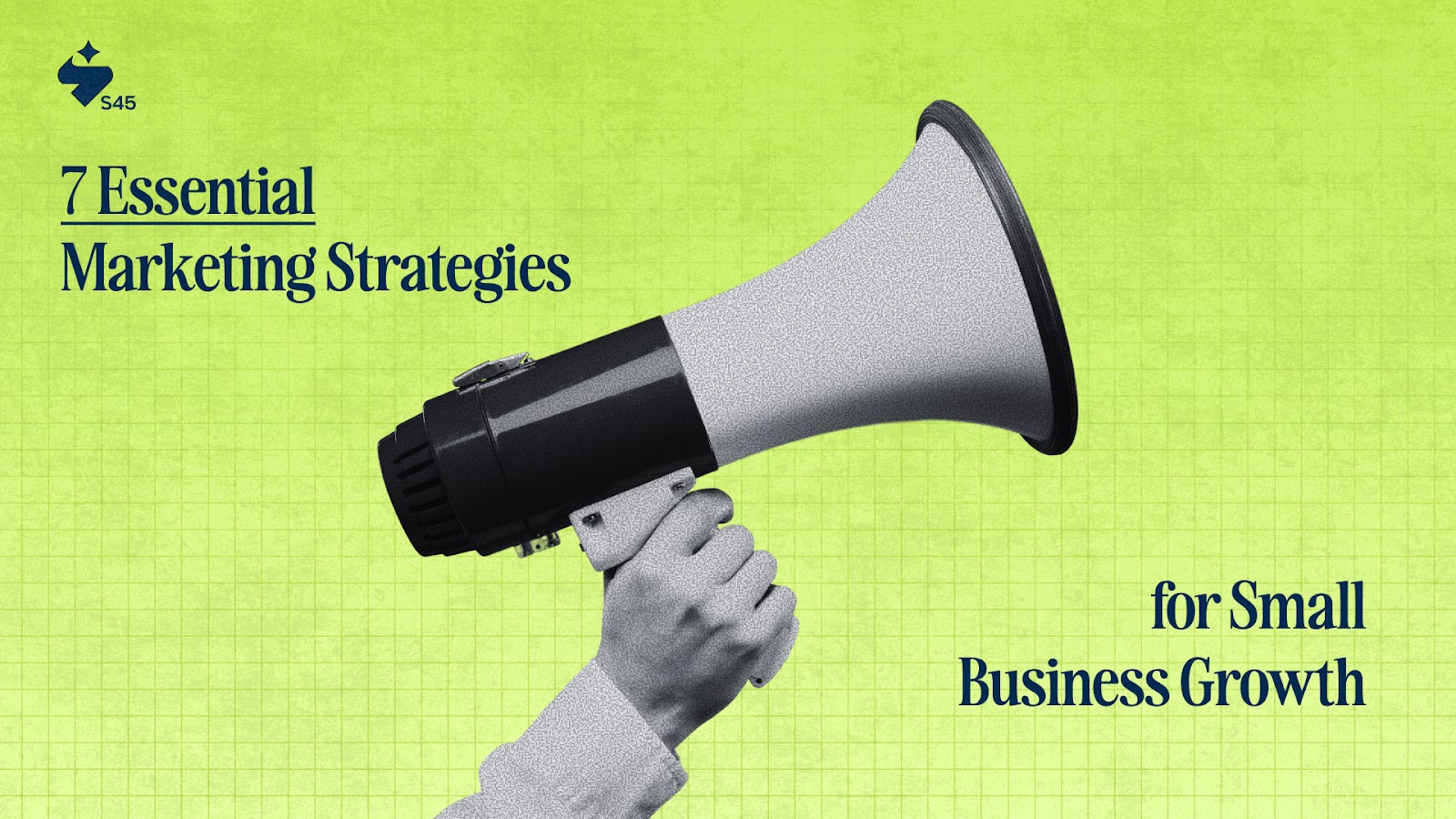
Growing a business isn’t about luck; it’s about smart choices. Take the Union Budget 2025-26, which allocates Rs 13,000 crores for the PM Vishwakarma scheme to help artisans and craftspersons expand their reach through better marketing and product visibility.
Yet, as a founder or CEO, you often struggle with the same challenge: you know your product has value, but getting it noticed in a crowded market feels overwhelming. That’s where a clear plan makes all the difference.
By applying 7 business growth marketing strategies for SME, you can move beyond scattered efforts and start building a system that drives consistent visibility, sales, and trust.
Key Takeaways:
- Focus on strategies that deliver measurable growth, email, social media, content, SEO, and mobile; all work best when chosen based on your stage and audience.
- Offline channels like print, radio, and community events still build trust, especially in Tier 2/3 markets, and work even better when paired with digital.
- Experiential marketing helps SMEs create lasting connections, while consistent storytelling builds authority and credibility with both customers and investors.
- Always track outcomes like leads, sales, and customer retention instead of chasing vanity metrics; small, consistent wins compound into long-term growth.
- S45 is about aligning structured marketing execution with clear, measurable outcomes so SMEs grow steadily without stretching resources too thin.
Why These Marketing Strategies Matter for Indian Founders

The right strategies turn sporadic sales into steady growth you can count on. No inconsistency, no guess-games. Here’s why these 7 business growth marketing strategies for SME truly matter for you:
- Tackle inconsistent demand: Most SMEs in India face sales cycles that swing with festivals, local events, or seasonal demand. These strategies create steady inflows by diversifying channels—so you’re not relying only on one source of business.
- Lower marketing costs under tight budgets: You don’t have Fortune 500 ad money. Referral marketing and SEO can stretch every rupee, bringing compounding returns over time instead of short-lived ad spikes.
- Build credibility faster in crowded markets: Whether it’s D2C apparel or SaaS, customers are spoilt for choice. Content marketing and experiential campaigns let you show proof of value instead of shouting into the void.
- Win locally, scale nationally: Many Indian startups begin with a city-first model. Local SEO, WhatsApp outreach, and traditional touchpoints give you a grip in one market before expanding to others.
- Balance short-term wins with long-term brand equity: Social media ads can give quick traction, but SEO and email build your brand’s staying power. A smart mix avoids burning cash for short-term highs.
- Keep investors and lenders confident : A founder’s story is stronger when backed by predictable growth channels. Consistent data from these strategies helps secure funding or credit lines without overpromising.
- Turn customers into repeat buyers and advocates: Retention is cheaper than acquisition. Referral marketing enhances customer retention by 16% higher lifetime value, providing SMEs a practical edge in maintaining steady revenue while generating new leads through existing networks.
You can partner with S45club to build equity strategies that fuel long-term growth, not just your next round.

#1 Email Marketing
For all the noise around new platforms, email still drives some of the highest returns. For every ₹80 you spend, you can expect returns of around ₹2,800–₹3,300.
It’s direct, measurable, and builds trust with people who’ve already shown interest.
1. Start Simple with Segmentation
Don’t treat every customer the same. Divide your audience by where they are in the buying journey:
- Prospects: Send simple intro emails explaining who you are, why you exist, and what problem you solve.
- First-time buyers: Follow up with thank-you mails, product usage guides, or FAQs. This helps reduce returns and boosts confidence.
- Repeat buyers: Reward loyalty with exclusive offers, referral invites, or early access to new products.
Why this matters: Segmentation ensures your emails feel personal instead of “spammy,” which improves open rates and conversions.
2. Build Smart Campaigns
Think of email as a drip, not a flood.
- Drip campaigns: A 3–5 mail sequence works best. For example, Mail 1 = Welcome, Mail 2 = Story/Product Value, Mail 3 = Special Offer.
- Re-engagement mails: Target inactive users with “We miss you” notes or festival offers.
- Localized offers: A Diwali discount or a city-specific event invite shows you’re connected to your customer’s context.
Why this matters: Campaigns done right keep your business top of mind without overwhelming the customer.
3. Use Affordable Tools
You don’t need enterprise software. Start with tools that Indian SMEs already trust:
- SendinBlue (Brevo): simple automation, cost-friendly.
- Mailchimp: great for templates and small lists.
- Zoho Campaigns: integrates well if you already use Zoho products.
Why this matters: These tools automate sending, track performance, and save your team from manual follow-ups.
4. Measure What Counts
Don’t just send emails; track what they actually do for your business. Focus on metrics that connect directly to growth:
- Open Rate: Shows if your subject lines and sender name spark interest.
- Click-Through Rate (CTR): Tells you if your content or offer is engaging enough to make people act.
- Conversion Rate: Tracks how many readers actually buy, sign up, or take the action you wanted.
- Bounce Rate: Flags bad or outdated email addresses that hurt deliverability.
- Unsubscribe Rate: Helps spot if you’re sending too often or to the wrong segment.
- Revenue per Email: The most practical measure for a founder; it shows which campaigns actually make money.
Pro tip: Don’t obsess over vanity metrics. A smaller, well-segmented list that drives sales is worth more than a massive list that never converts.
Stop thinking in terms of one-off raises. With S45club, align your financing decisions with your company’s bigger vision.
#2 Social Media Marketing
For many SMEs, social media feels like a noisy bazaar, everyone shouting, few listening. But used wisely, it can turn into your most powerful storytelling tool. In India, over 470 million people use social media actively (Statista 2025), and they’re not just scrolling, they’re buying, reviewing, and sharing.
The key is to treat social media less like a billboard and more like a conversation space.
1. Pick the Right Platforms
Don’t stretch yourself thin across every app. Choose platforms based on your audience and business model:
- LinkedIn: Ideal for B2B, SaaS, and professional services. Thought leadership posts, founder updates, and case studies work well here.
- Instagram & Facebook: Strong for D2C brands, retail, fashion, and food. Visual storytelling and reels build trust and aspirational pull.
- WhatsApp Business: Excellent for customer service, product catalogs, and direct selling in India’s mobile-first market.
Tip: Start with one or two platforms you can manage consistently, rather than chasing all.
2. Create Content That Builds Trust
You’re not competing on who shouts louder but on who feels more real.
- Show your product in action, short videos, behind-the-scenes stories, customer testimonials.
- Use regional language content to connect with Tier 2/3 audiences. A simple Tamil or Hindi caption can multiply engagement.
- Collaborate with micro-influencers. Smaller creators often drive more meaningful conversions than celebrity endorsements.
3. Balance Organic and Paid
Organic posts build your brand voice, but ads help scale reach faster.
- For early-stage growth, test low-budget targeted ads, ₹500–₹1,000 a day on Facebook/Instagram can give measurable results.
- Track CAC (customer acquisition cost) versus lifetime value. If the numbers don’t add up, pause and rework campaigns instead of pouring more money.
4. Drive Conversions, Not Just Likes
A founder doesn’t care about vanity metrics. Focus on outcomes:
- Use clear CTAs: “Shop Now,” “Sign Up,” “Book a Demo.”
- Link ads and posts to landing pages with simple forms, not just your homepage.
- Encourage direct actions, such as WhatsApp inquiries, in-store visits, or referrals.
5. Measure What Matters
Tracking the right metrics ensures you’re not just active on social but actually moving the needle for your business. Here are the key ones to focus on:
- Engagement Rate: Shows how many people actually interact, not just view.
- Cost per Lead/Sale: Crucial for budgeting.
- Referral Traffic: How much website traffic comes from social channels.
- Customer Feedback: Comments and DMs give unfiltered insight into what your audience cares about.
#3 Content Marketing
If social media is your conversation, content is the substance behind it. For SMEs, this is where you show depth, not just that you exist, but why you matter. Founders who consistently publish useful, thoughtful content build trust faster, both with customers and with investors watching from the sidelines.
In India’s crowded markets, authority often wins over ad spend.
1. Decide on Your Core Themes
Your content should answer the questions your buyers already have.
- B2B startups: Case studies, industry insights, how-to guides.
- D2C brands: Product comparisons, lifestyle blogs, customer stories.
- Local SMEs: FAQs, “how we do it” posts, festival-specific content.
Focus on 2–3 themes tied directly to your product and audience pain points, instead of writing about everything.
2. Pick the Right Formats
Don’t just default to long blogs. Mix formats based on audience behavior:
- Short blogs or explainers: Great for SEO and answering search queries.
- Videos and reels: Perfect for showing product use cases.
- Whitepapers or reports: Strong for B2B credibility.
- Regional content: A Tamil or Hindi video often connects better in Tier 2/3 markets than an English blog.
3. Create for Authority, Not Clickbait
As a founder, you don’t need to churn endless posts; you need quality that makes you look credible.
- Publish founder-written opinion pieces on LinkedIn.
- Share lessons learned from your own business journey.
- Use customer testimonials and case studies as storytelling tools.
4. Build a Distribution Habit
Creating content isn’t enough; you need eyes on it.
- Repurpose one blog into a LinkedIn post, an Instagram carousel, and an email snippet.
- Share content with partners, accelerators, or local communities to widen reach.
- Encourage employees to share; it adds authenticity.
5. Measure Content ROI
Content shouldn’t just “look good.” Track outcomes like:
- Leads generated through gated content (downloads, sign-ups).
- Keyword rankings improve SEO visibility.
- Increased inbound inquiries or demo requests.
- Engagement and reshares from your target audience (not random likes).
Access late-stage deal flow, pre-IPO opportunities, and smarter capital strategies usually reserved for insiders. Join the S45club and scale with clarity!
#4 Local SEO
Most SMEs in India spend money on ads but forget that 68% of online experiences start with a search (HubSpot). For a founder, this means your potential customer is already looking for you, or someone like you, before you’ve even run a campaign.
If you’re not visible in that moment, you’re invisible. SEO is about building that visibility in a way that compounds over time instead of disappearing the second you stop paying for ads.
1. Focus on Local First
For most SMEs, business starts close to home.
- Claim and update your Google Business Profile, address, hours, photos, and reviews.
- Encourage happy customers to leave reviews. In India, reviews often tip the balance more than discounts.
- Use location-based keywords like “best HR software in Bangalore” or “affordable furniture Jaipur.”
Local SEO ensures you don’t just show up on Google—you show up for the buyers most likely to walk in or call.
2. Create Searchable Content
Don’t write blogs just to publish. Write to answer the exact questions your buyers type into Google.
- For B2B: Problem-based content like “how SMEs reduce payroll errors”.
- For D2C: Buying guides, comparisons, and festival shopping ideas.
- For services: FAQs, “how it works,” and “cost of” pages, these often rank faster and convert better.
Think of content as “digital storefront signage.” Clear, specific, and answer what buyers need to know.
3. Get the Technical Basics Right
A fast, mobile-friendly site is non-negotiable in India’s mobile-first economy.
- Mobile-first design: If your site doesn’t load in 3 seconds, many users will drop off.
- Simple navigation: Don’t bury pricing or product details under 5 clicks.
- Secure site (HTTPS): Google favors it, and customers trust it.
Technical SEO isn’t just for Google; it’s for the customer experience that Google rewards.
4. Build Authority with Backlinks
Search engines trust you when others do.
- Partner with local directories, trade associations, and startup networks.
- Guest post on industry blogs or collaborate with influencers who link back to your site.
- Even regional press mentions count; many Indian SMEs overlook this.
Backlinks are like digital word-of-mouth; they signal to Google that you’re credible.
5. Track What Actually Drives Business
Don’t drown in SEO dashboards. Focus on:
- Keyword rankings for terms tied to purchase intent.
- Organic traffic growth month over month.
- Leads or sales from organic search, not just visitors.
- Call or inquiry tracking from local search.
#5 Mobile Marketing
India is a mobile-first country. Over 75% of internet traffic here comes from smartphones (Statista 2025). From shopping to UPI payments, your customers’ daily life runs through their phones. For an SME founder, mobile marketing isn’t optional; it’s where relationships are built, orders are confirmed, and repeat business is secured.
1. Use WhatsApp Business Smartly
WhatsApp has become the default channel for customer communication in India. It’s direct, trusted, and familiar.
- Set up product catalogs so buyers can browse easily.
- Use quick replies and auto-greetings to handle common questions.
- Share order updates, festival offers, or event invites via broadcast lists.
2. Keep SMS and Push Notifications Short
SMS still matters in India, especially for transactional or time-sensitive updates. Push notifications help drive app re-engagement, but only in moderation.
- Send urgent alerts like payment confirmations, delivery updates, or flash sales.
- Use push notifications for reminders (loyalty points, new arrivals).
- Limit frequency to avoid being muted or blocked.
3. Localize Your Messaging
Regional relevance can dramatically increase response rates. A message tied to a festival or in a local language feels personal.
- Add cultural context: “Diwali Dhamaka Offer” or “Onam Special Discount.”
- Translate simple offers into local languages for Tier 2 and Tier 3 markets.
- Time campaigns around festivals, state holidays, or local events.
4. Add Value, Not Spam
Customers ignore channels that only push discounts. Use mobile to solve problems and make life easier.
- Share practical tips or short how-to videos.
- Send delivery updates and easy payment links.
- Reward loyalty with reminders about points, memberships, or referral perks.
5. Track Mobile ROI
Without tracking, mobile campaigns become guesswork. Focus on metrics tied to outcomes, not vanity numbers.
- Monitor click-through rates on SMS and notifications.
- Track conversions from WhatsApp campaigns.
- Measure repeat app opens after push campaigns.
- Calculate cost per action to check if campaigns actually drive sales or leads.
#6 Traditional Marketing
Digital may dominate conversations, but offline channels still carry weight in India, especially in Tier 2 and Tier 3 markets. Flyers, radio, posters, and community events often feel more trustworthy to local buyers than digital ads alone. For an SME founder, traditional marketing isn’t outdated—it’s a way to build credibility and visibility where your customers actually live and work.
1. Print That Still Converts
Local print is far from dead. It’s often the first touchpoint in smaller towns and cities.
- Advertise in local newspapers read by your target audience.
- Distribute flyers in busy areas like markets, bus stands, or housing complexes.
- Add QR codes on posters/flyers to connect offline visibility with online actions.
2. Radio and Local Media
Radio reaches millions daily in India at low cost, and regional FM stations carry a strong influence.
- Run short ads during peak commuting hours.
- Partner with regional channels for shout-outs or sponsored shows.
- Use jingles that are easy to recall and connect emotionally.
This might sound too outdated. But it truly works for many businesses.
3. Community and Event Sponsorships
Offline presence in local communities builds brand familiarity faster than digital in some markets.
- Sponsor school events, sports tournaments, or local fairs.
- Set up stalls at exhibitions or trade expos relevant to your industry.
- Collaborate with co-working hubs or incubators for SME networking.
4. Combine Offline with Digital
The smartest use of traditional marketing is blending it with online channels.
- Add short links or QR codes leading to WhatsApp or website offers.
- Collect phone numbers or emails at events to bring leads into digital funnels.
- Use photos and videos from offline events on social media for credibility.
5. Measure Offline ROI
Traditional doesn’t mean untrackable. With simple hacks, you can measure impact.
- Use unique phone numbers or codes in flyers/radio ads.
- Track QR code scans or coupon redemptions from offline campaigns.
- Compare local footfall during campaigns with normal weeks.
#7 Experiential Marketing
Customers forget ads but remember experiences. For SMEs, experiential marketing isn’t about large-scale expos or celebrity events; it’s about creating small but memorable touchpoints where people can interact with your brand directly.
1. Start with Small Pop-Ups
You don’t need a massive budget to make an impact.
- Set up tasting booths, demo counters, or trial kiosks at malls or local markets.
- Showcase how your product works; live demonstrations build instant credibility.
- Offer samples or small giveaways that encourage trial.
2. Host Workshops or Demos
Workshops educate while promoting your brand.
- A fitness SME could run free morning yoga sessions with branded mats.
- A furniture maker might host “DIY maintenance” workshops.
- Partner with schools, NGOs, or co-working spaces for higher footfall.
3. Tie Events to Local Culture
Festivals and community events are natural gathering points in India.
- Offer Diwali or Holi-themed pop-ups to link your brand with celebration.
- Participate in local melas, fairs, or cultural gatherings.
- Sponsor or co-create experiences that feel authentic to the region.
4. Capture and Amplify Online
Offline experiences don’t stay offline if you share them well.
- Encourage visitors to share photos with hashtags or QR-linked offers.
- Post event highlights on Instagram, LinkedIn, or YouTube.
- Run contests where customers tag your brand for prizes.
5. Track Impact Beyond Attendance
Don’t just count how many people showed up, track what changed.
- Monitor leads generated during events (sign-ups, inquiries).
- Compare sales spikes during and after the activity.
- Track online mentions or engagement tied back to the event.
Growth doesn’t come from chasing every trend, but from choosing the right moves and repeating them with intent. Apply these 7 business growth marketing strategies for SME, track what works, and you’ll build a system that turns effort into steady, lasting results.
Final Thoughts
For SMEs, growth is rarely about doing more; it’s about doing the right things with focus. Each of the 7 business growth marketing strategies for SME is designed to solve a real challenge you face: from inconsistent demand and limited budgets to building trust in crowded markets. The smartest approach is to start small, test what works for your audience, and double down on the channels that show measurable returns.
Stay consistent, keep refining, and don’t ignore the basics; clear messaging, timely follow-ups, and customer retention often deliver more value than chasing the newest fad. When you treat marketing as a long-term system rather than a one-time push, you’ll create growth that doesn’t just spike, but sustains.
Want to learn from founders who’ve already walked the funding path? Join the S45 founder community to exchange insights, share playbooks, and stay sharp together.
Frequently Asked Questions
Q. How can I measure the success of my marketing without getting lost in vanity metrics?
A. Focus on outcomes tied to growth, not just likes or clicks. For example, track how many inquiries turn into paying customers or how many repeat purchases happen after a campaign. These numbers tell you whether your strategy is creating real revenue impact. When you align this with the 7 business growth marketing strategies for SME, you’ll see how each tactic contributes to long-term sustainability.
Q. What’s the risk of trying too many strategies at once?
A. The biggest risk is spreading your limited resources too thin. Many SMEs jump into every channel, ads, reels, blogs, and events, only to burn out and see no measurable return. Marketing works best when you focus on 2–3 strategies at a time, track their results, and scale gradually. Using the 7 business growth marketing strategies for SME as a framework helps you prioritise what matters most.
Q. How can referral marketing fit into a growth plan for SMEs?
A. Referral marketing is one of the most underused levers for SMEs. It reduces acquisition costs by turning existing customers into advocates. Data shows referrals deliver a 16% higher lifetime value compared to other channels. When combined with the 7 business growth marketing strategies for SME, referrals act as a multiplier, boosting trust, retention, and revenue without heavy ad spends.
Q. What role does customer feedback play in shaping these strategies?
A. Customer feedback is the cheapest and most powerful marketing insight you can get. Regularly check reviews, DMs, or direct conversations for clues on what’s working and what’s not. If customers praise your service speed, highlight it in campaigns. If they’re confused about pricing, fix your messaging. Integrating this feedback into the 7 business growth marketing strategies for SME makes them sharper and more effective.
Q. How do I balance short-term sales goals with long-term brand building?
A. Think of it like a cricket match. Quick runs come from tactical shots, flash sales, ads, or festival promotions. Long-term brand equity comes from steady partnerships, customer loyalty, and consistent storytelling. SMEs should maintain a mix: allocate part of the budget to activities that generate immediate sales and another part to branding strategies like content and referrals that compound value over time.


